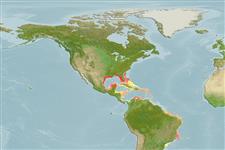Environment: milieu / climate zone / intervalo de profundidade / distribution range
Ecologia
marinhas associadas(os) a recifes; intervalo de profundidade 0 - 110 m. Tropical; 32°N -
Western Atlantic: Bermuda, Georgia and northeastern Gulf of Mexico in USA.
Tamanho / Peso / Idade
Maturidade: Lm ? range ? - ? cm
Max length : 7.5 cm TL macho/indeterminado; (Ref. 7251)
Raios dorsais moles (total) : 13 - 17; Espinhos anais: 2; Raios anais moles: 20 - 23. Species distinguished by: cirrus on eye present, longer than eye diameter in males (and often in females) and arising from single base; supraorbital cirrus distinctly banded, up to 3 times as long as eye diameter; no bony ridges on rear half of interorbital region; head smooth anteriorly, never spiny; males without flag-like flap on base of first dorsal-fin spine; segmented dorsal-fin rays 13 to 17; total dorsal-fin elements 30 to 38; pectoral-fin rays usually 14; anal-fin rays 20 to 23; 3 obvious segmented pelvic-fin rays (third ray goes 4 or fewer times in length of longest); tip of lower jaw not projecting beyond tip of upper jaw and without fleshy projection; no stripe or series of dark blotches on head and body; one row of teeth on each palatine bone. Common amongst Chaenopsids: small elongate fishes; largest species about 12 cm SL, most under 5 cm SL. Head usually with cirri or fleshy flaps on anterior nostrils, eyes, and sometimes laterally on nape; gill membranes continuous with each other across posteroventral surface of head. Each jaw with canine-like or incisor-like teeth anteriorly; teeth usually also present on vomer and often on palatines (roof of mouth). Dorsal-fin spines flexible, usually outnumbering the segmented soft rays, spinous and segmented-rayed portions forming a single, continuous fin; 2 flexible spines in anal fin; pelvic fins inserted anterior to position of pectoral fins, with 1 spine not visible externally; all fin rays, including caudal-fin rays, unbranched (simple). Lateral line absent. Scales absent (Ref.52855).
Body shape (shape guide): elongated.
Found in intertidal areas in Bermuda. Occurs in deeper water from 30-110 m in USA.
Life cycle and mating behavior
Maturidade | Reprodução | Desova | Ovos | Fecundidade | Larvas
Robins, C.R. and G.C. Ray, 1986. A field guide to Atlantic coast fishes of North America. Houghton Mifflin Company, Boston, U.S.A. 354 p. (Ref. 7251)
Categoria na Lista Vermelha da IUCN (Ref. 130435: Version 2025-1)
Ameaça para o homem
Harmless
Utilização humana
Ferramentas
Relatórios especiais
Descarregue XML
Fontes da internet
Estimates based on models
Preferred temperature (Ref.
123201): 22.1 - 27.5, mean 25.6 °C (based on 156 cells).
Phylogenetic diversity index (Ref.
82804): PD
50 = 0.5000 [Uniqueness, from 0.5 = low to 2.0 = high].
Bayesian length-weight: a=0.00525 (0.00219 - 0.01260), b=3.06 (2.85 - 3.27), in cm total length, based on LWR estimates for this (Sub)family-body shape (Ref.
93245).
Nível Trófico (Ref.
69278): 3.6 ±0.5 se; based on size and trophs of closest relatives
Fishing Vulnerability (Ref.
59153): Low vulnerability (10 of 100).
🛈
